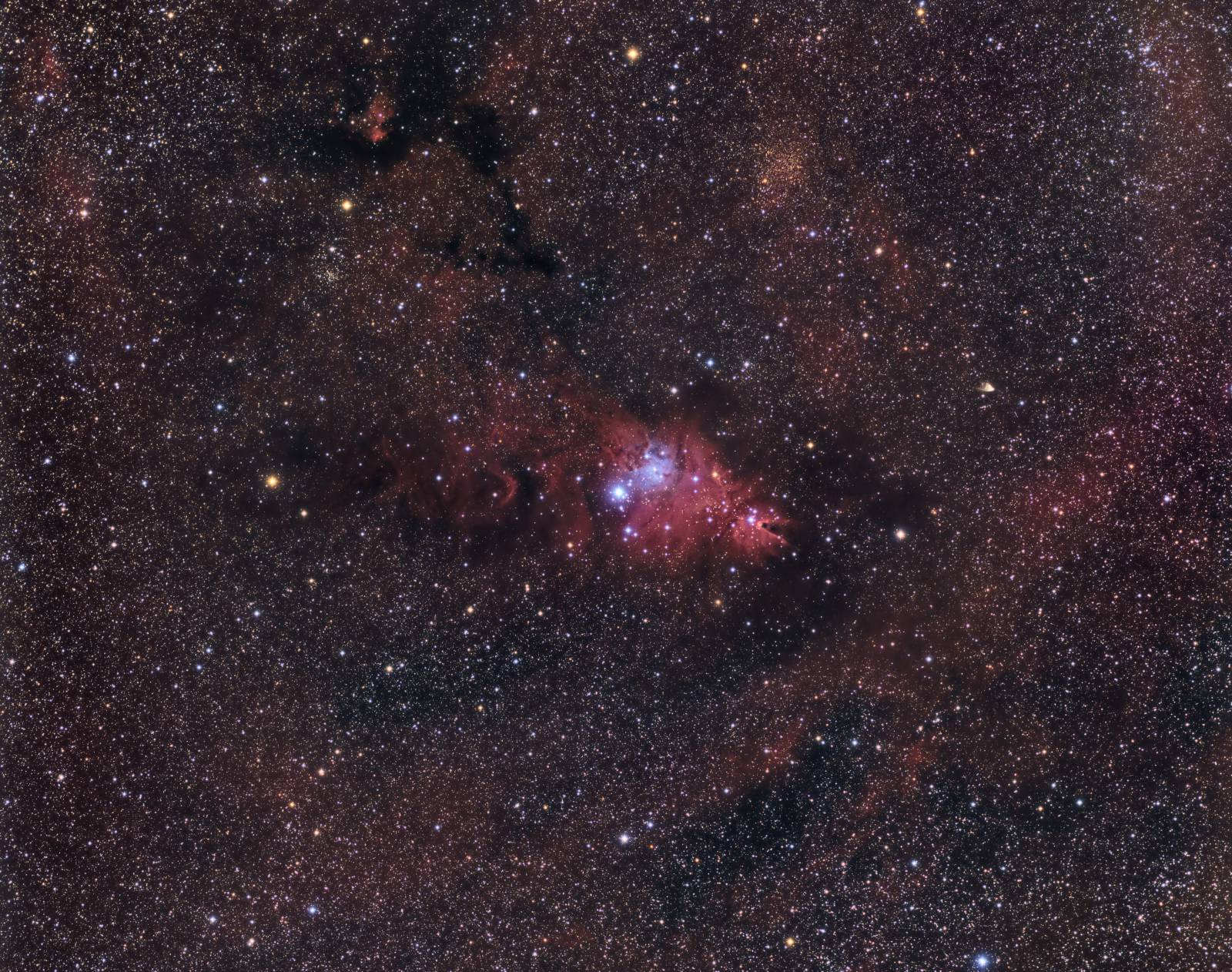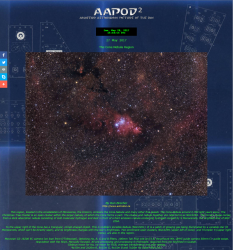Cone Nebula Region
 Click image for full size version
Click image for full size version
March 20, 2017, Amateur Astronomy Picture of the Day, May 27, 2017
 This region, located in the constellation of Monoceros, the Unicorn, contains the Cone Nebula and many other fine jewels. The Cone Nebula around 2,700 light years away. The Christmas Tree Cluster is an open cluster within the larger nebula, of which the Cone forms a part. The cluster and nebula together are referred to as NGC2264. The Cone’s shape comes from a dark absorption nebula consisting of cold molecular hydrogen and dust in front of a faint emission nebula containing hydrogen ionized by S Monocerotis, the brightest star of NGC 2264.
This region, located in the constellation of Monoceros, the Unicorn, contains the Cone Nebula and many other fine jewels. The Cone Nebula around 2,700 light years away. The Christmas Tree Cluster is an open cluster within the larger nebula, of which the Cone forms a part. The cluster and nebula together are referred to as NGC2264. The Cone’s shape comes from a dark absorption nebula consisting of cold molecular hydrogen and dust in front of a faint emission nebula containing hydrogen ionized by S Monocerotis, the brightest star of NGC 2264.
To the upper right of the Cone lies a triangular, comet-shaped object. This is Hubble’s Variable Nebula (NGC2261). It is a patch of glowing gas being illuminated by a variable star (R Monocerotis, which can’t be directly seen), and its brightness changes with the star’s brightness. Two prominent open clusters, NGC2259 (upper left of Cone) and Trumpler 5 (upper right Cone), are also in this region. Another elongated open cluster, NGC2251, is in the extreme upper right corner.
Trumpler 5 is worth a closer look. It is unusual for an open cluster, being made up mostly of yellow, red and orange stars. Most open clusters are bluish or whitish, because we see them when they’re young and contain more blue/white stars, before they dissipate at a relatively young age. Trumpler 5 is a relatively old open cluster, and its blue/white stars have long since used up their fuel and gone dim. This accounts for the pretty hue of the cooler, redder stars that remain.
Tekkies:
Moravian G3-16200 EC camera (on loan from O’Telescope), Optolong Ha, R, G and B filters, 106mm Tak FSQ-106 at f/3.6, Paramount MX, QHY5 guide camera 50mm f.l. guide scope. Acquisition with the SkyX, Manually focused. All pre-processing and processing in PixInsight. Acquired from my SkyShed in Guelph. Gibbous moon for Ha, no moon for RGB, average transparency and poor seeing.
4x15m and 2x20m R, 8x15m G, 9x15m B and 7x20m Ha (total=8hr15m).
NB-RGB Creation
Creation and cleanup: R, G, B and Ha masters were cropped and processed separately with DBE. R, G and B were combined to make an RGB image which was processed with BackgroundNeutralization. ColorCalibration was applied. The NBRGBCombination script was run using Ha for red narrowband and a scale of 1.2. HistogramTransformation was used to balance the colour channel’s black point on both the RGB and HaRGB images. A mask was used to blend the blue structure from the RGB into the HaRGB image using PixelMath. RGBWorkingSpace was used to equalize the HaRGB colour channels, and the luminance was extracted for separate processing as Synthetic Luminance (see below)
Linear Noise Reduction: MultiscaleLinearTransform was used to reduce noise in the background areas of the NB-RGB file. Layer settings for threshold and strength: Layer 1: 3.0, 0.6 Layer 2: 2.0, 0.45 Layer 3: 1.5, 0.33 Layer 4: 1.0, 0.2 and Layer 5: 0.5, 0.13
Stretching: HistogramTransformation was applied to make a bright, pleasing image.
Synthetic Luminance:
Creation and cleanup of SynthL: TheSynthL was made by extracting the luminance from the linear HaRGB image.
Deconvolution: A star mask was made to use as a local deringing support. A copy of the image was stretched to use as a range mask. Deconvolution was applied (80 iterations, regularized Richardson-Lucy, external PSF made using DynamicPSF tool with about 20stars).
Linear Noise Reduction: MultiscaleLinearTransform was used to reduce noise in the background areas of the NB-RGB file. Layer settings for threshold and strength: Layer 1: 3.0, 0.6 Layer 2: 2.0, 0.45 Layer 3: 1.5, 0.33 Layer 4: 1.0, 0.2 and Layer 5: 0.5, 0.13.
Stretching: HistogramTransformation was applied using autostretch settings from ScreenTransferFunction.
Noise Reduction and Re-Stretch: TGVDenoise was applied in Lab mode with 300 iterations with a range mask used to protect high signal areas. This was followed by a HistogramTransformation to raise the black point (but with no clipping).
Combining SynthL with NB-RGB:
The processed SynthL was applied to the NB-RGB image using LRGBCombine.
Additional Processing
Contrast Enhancement: The contrast was boosted in the brightest portions of the nebula with 2 passes of LocalHistogramEqualization (scale 52 with strength 0.33 and scale and 165 with strength 0.2, max contrast 1.5) using a mask to protect background and stars.
Final Steps: MultiscaleLinearTransform was used to sharpen the structures in the bright parts of the nebula (layers 2-4 at 0.05), followed by a pass of TGVDenoise on the L channel only, using default settings. Background, nebula and star brightness, contrast and saturation were adjusted in several iterations using Curves with masks as required. SCNR was applied to the background. MorphologicalTransformation was applied with the Morphological Selection operator (size 3, 3 iterations, amount 0.17, selection 0.23).
Image scale is about 3.2 arcsec per pixel for this camera / telescope combination.






Fantastic work creating Cone Nebula and Christmas Tree Cluster –
Astrodoc: Astrophotography by Ron Brecher.
Thanks!